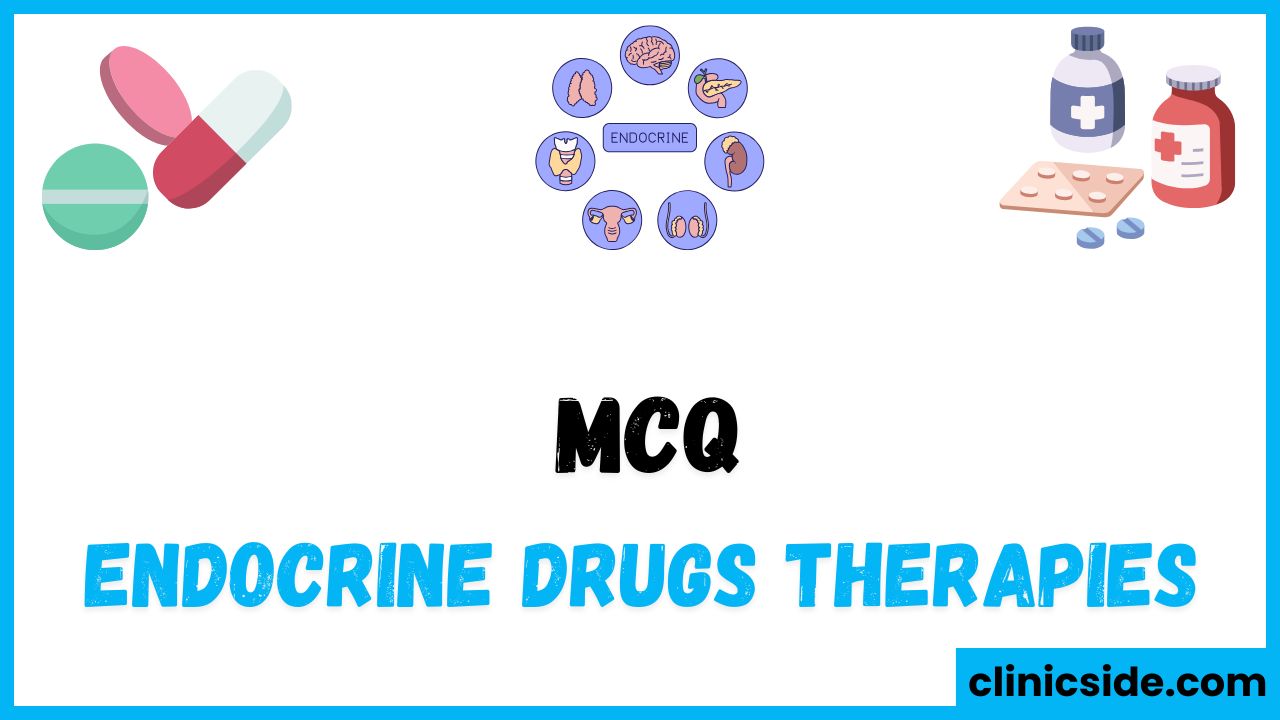Quiz
Available options: 1 to 20
Summary of Endocrine Drugs Therapies
Severe Hypercalcemia and Malignancy-Associated Hyperparathyroidism
In treating severe hypercalcemia associated with malignancy-induced hyperparathyroidism, Bisphosphonates are the primary drugs used. These work by inhibiting bone resorption, leading to a decrease in elevated calcium levels. While other treatments such as Cinacalcet and Calcitonin may be utilized, bisphosphonates are most effective in managing acute hypercalcemia in cancer patients.
Managing Insulin Resistance in Type 2 Diabetes
Thiazolidinediones (TZDs), such as Pioglitazone, are used to reduce insulin resistance in type 2 diabetes by activating the PPAR-γ receptor, which enhances insulin sensitivity and glucose uptake. Metformin, another drug commonly used in diabetes, works by lowering hepatic glucose production but does not directly improve insulin sensitivity.
Mechanism of Eplerenone in Heart Failure and Hypertension
Eplerenone is an aldosterone antagonist employed to manage hypertension and heart failure. It blocks aldosterone’s effects, leading to reduced sodium and water retention. This action helps lower blood pressure and prevents fluid overload, making it especially useful in patients with heart failure or high blood pressure.
Preventing Glucocorticoid-Induced Osteoporosis
For glucocorticoid-induced osteoporosis, Bisphosphonates like Alendronate are first-line treatments. These medications help prevent bone loss by inhibiting osteoclast-mediated resorption. Additional therapies such as Denosumab or Vitamin D may also be prescribed to improve bone health in these patients.
Role of Etelcalcetide in Managing Secondary Hyperparathyroidism
Etelcalcetide, a calcimimetic drug, is used in secondary hyperparathyroidism, particularly in patients with chronic kidney disease (CKD). It reduces parathyroid hormone (PTH) secretion by activating calcium-sensing receptors in the parathyroid gland. This helps to control calcium and phosphate balance, preventing complications related to high PTH levels.
Pramlintide as an Amylin Analog in Diabetes Care
Pramlintide, an amylin analog, is used to manage both type 1 and type 2 diabetes. It mimics the effects of amylin, a hormone that helps regulate post-meal blood glucose by slowing gastric emptying and inhibiting glucagon secretion. This aids in blood sugar control, especially when used alongside insulin.
Common Side Effects of GLP-1 Receptor Agonists
GLP-1 receptor agonists, such as Liraglutide and Exenatide, enhance insulin secretion, slow gastric emptying, and reduce appetite. However, these drugs may lead to pancreatitis, a serious adverse effect that requires regular monitoring. Other common side effects include gastrointestinal discomfort, particularly at the start of treatment.
Octreotide in the Management of Acromegaly
Octreotide, a synthetic somatostatin analog, is used to treat acromegaly, a condition caused by excessive growth hormone (GH) secretion. By inhibiting GH release from the pituitary gland, Octreotide alleviates the characteristic symptoms of acromegaly, such as abnormal growth of facial features and hands.
Cinacalcet’s Role in Secondary Hyperparathyroidism
Cinacalcet, a calcimimetic drug, plays an essential role in treating secondary hyperparathyroidism, particularly in chronic kidney disease patients. It helps reduce parathyroid hormone (PTH) secretion by mimicking calcium’s effects on the parathyroid glands, thus improving calcium and phosphate homeostasis.
Treatment Options for Thyroid Disorders and Their Effects
- Levothyroxine is the standard treatment for hypothyroidism, replenishing deficient thyroid hormones. Incorrect dosing can result in hyperthyroidism-like symptoms, such as tachycardia, weight loss, and anxiety.
- Propylthiouracil (PTU) and Methimazole are used to manage hyperthyroidism. PTU is often preferred during pregnancy due to its lower teratogenic risk, though it carries a risk of liver toxicity, necessitating regular monitoring.
- Radioactive iodine (I-131) is used in the treatment of thyroid cancer and hyperthyroidism by selectively destroying thyroid tissue. However, this treatment can lead to hypothyroidism in the long term.
- Beta-blockers such as Propranolol are used to manage symptoms of hyperthyroidism like tachycardia and tremors. Although they do not address the underlying thyroid issue, they provide symptomatic relief for cardiovascular symptoms.
In conclusion, these treatments demonstrate the various pharmacological approaches to managing endocrine disorders such as diabetes, thyroid diseases, and calcium imbalances. A thorough understanding of these drug mechanisms, their side effects, and appropriate indications ensures better management of patients dealing with these conditions.





